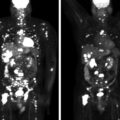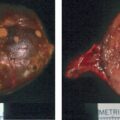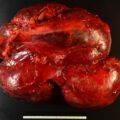Lipid-poor adrenal masses are the landmines of adrenal disorders. Although lipid-poor adrenal masses may be benign nonfunctional cortical adenomas, it can be difficult to make the distinction from more concerning diagnoses such as small adrenocortical carcinoma (ACC) (see Cases 6 and 23) or prebiochemical pheochromocytoma (see Case 36). Choosing nonsurgical management can carry clinically significant risk. Unless metastatic disease or infection is strongly suspected, adrenal biopsy should be avoided. There are atypical presentations of nearly all adrenal disorders, and caring for these patients can be a humbling experience. Herein we present such a case.
Case Report
The patient was a 59-year-old man referred for an evaluation of an incidentally discovered right adrenal mass. He had been hypertensive for 15 years and was treated with a β-adrenergic blocker, thiazide diuretic, and a calcium channel blocker. His home blood pressure measurements averaged 150s/60s mm Hg. There was no history of hypokalemia. He had used tobacco in the past (60 pack-years) and 1 year ago had a contrast-enhanced pulmonary computed tomography (CT) scan to follow up lung nodules, and this detected a new 2.5-cm right adrenal mass. The referral to Mayo Clinic was to follow up on that incidental finding. The patient had no signs or symptoms of pheochromocytoma beyond sustained hypertension. He had no signs or symptoms of malignancy or infection (e.g., no fever, cough, or weight loss). On physical examination his body mass index was 28.9 kg/m 2 , blood pressure 136/73 mmHg, and heart rate 77 beats per minute. He had no stigmata of Cushing syndrome.
INVESTIGATIONS
The baseline laboratory test results are shown in Table 83.1 . With the exception of fasting hyperglycemia, the laboratory tests were normal. A dedicated adrenal CT scan was performed. The isolated right adrenal mass measured 2.7 cm × 1.7 cm ( Fig. 83.1 ). The unenhanced CT attenuation was 39 Hounsfield units. The mass enhanced with contrast administration and had slow contrast washout. The remainder of the right adrenal gland appeared normal. The left adrenal gland appeared normal on CT ( Fig. 83.2 ). The chest CT scan performed elsewhere was not available for comparison. The outside reports indicated that bilateral pulmonary nodules were first detected 6 years previously when he had pleuritic right chest pain. The chest radiograph at that time showed a right pleural effusion—a biopsy was nondiagnostic. The chest CT scan from 1 year ago reported bilateral pulmonary nodules and some mediastinal lymphadenopathy.
| Biochemical Test | Result | Reference Range |
| Sodium, mmol/L Potassium, mmol/L Fasting plasma glucose, mg/dL Creatinine, mg/dL 1-mg overnight DST next day serum cortisol, mcg/dL Aldosterone, ng/dL Plasma renin activity, ng/mL per hour Plasma metanephrine, nmol/L Plasma normetanephrine, nmol/L 24-Hour urine: Metanephrine, mcg Normetanephrine, mcg Norepinephrine, mcg Epinephrine, mcg Dopamine, mcg | 147 3.8 147 1.3 1.8 22 1.4 0.28 0.5 166 533 51 2.8 350 | 135–145 3.6–5.2 70–100 0.9–1.3 <1.8 ≤21 ≤0.6–3 <0.5 <0.9 <400 <900 <80 <20 <400 |
Stay updated, free articles. Join our Telegram channel

Full access? Get Clinical Tree








